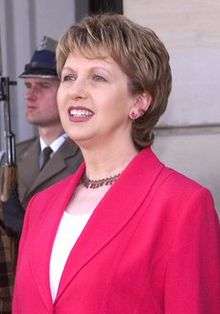Irish presidential election, 2004
| | |||||||||||||||||||||||
| |||||||||||||||||||||||
| |||||||||||||||||||||||
| |||||||||||||||||||||||
The Irish presidential election of 2004 was set for 22 October 2004. However, nominations closed at noon on 1 October and the incumbent president, Mary McAleese, who had nominated herself in accordance with the provisions of the Constitution, was the only person nominated. Accordingly, she was re-elected for a second seven-year term of office without the need to hold an election. This was the third time a president was returned unopposed, following Seán T. O'Kelly in 1952, and Patrick Hillery in 1983. McAleese was re-inaugurated on 11 November 2004.
Party positions
Fianna Fáil
The Fianna Fáil party supported its former candidate, Mary McAleese, in her bid for a second term. Technically, however, McAleese nominated herself rather than seek a nomination from Fianna Fáil.
Fine Gael
The Fine Gael party also supported Mary McAleese's bid for a second term.
Labour Party
In early 2003, the Labour Party said that the party would run a candidate, irrespective of the attitudes of other parties, and even in the event of the president seeking a second term. But party leader Pat Rabbitte appeared less committed during a television interview in November 2003, pointing out that all the party's attentions were focused on the two Irish elections already set for 2004, the European Parliament election and the local elections to be held on 11 June 2004. Following the significant losses of the ruling Fianna Fáil party in these elections, Labour Party sources suggested the presidential election should not be contested if it were to allow a decisive Fianna Fáil victory so soon after earlier election woes. Possible candidates were:
- Former party chairperson and Minister for Arts, Culture and the Gaeltacht, Michael D. Higgins
- Former Tánaiste (Deputy Prime Minister) Dick Spring
- Former leader Ruairi Quinn
- Independent Senator and gay rights campaigner David Norris
- Former Social Democratic and Labour Party minister in Northern Ireland and deputy SDLP leader, Bríd Rodgers
On 16 September 2004, the party's parliamentary party recommended not running a candidate. The final decision was taken by the party's executive body, the National Executive, on 17 September 2004. In a surprisingly tight vote, the executive decided against running Higgins by a majority of one, even though the party leader and parliamentary party had come out strongly against running a candidate.
Green Party
Green Party TD Eamon Ryan let it be known that he was interested in seeking a nomination to run. However, practical difficulties included a lack of support from non-Green Party parliamentarians (fourteen of whom would be needed to nominate, as well as the six Green Party TDs), Mary McAleese's personal popularity, and funding issues. Having been endorsed by the party leadership, Ryan subsequently withdrew his name before a meeting of the Green Party National Council[1] and the Green Party ultimately did not run a candidate.
Sinn Féin
Sinn Féin also supported Mary McAleese's bid for a second term.
Others
Independent TDs or Senators could have nominated an independent candidate, although they would have had difficulty securing the support of the necessary 20 TDs or senators. Possible candidates included:
- Senator David Norris – who did not receive a Labour Party nomination
- Kevin Lee – Former emigrant who had a campaign and contacted local councillors
- Vincent Salafia – Environmental activist and anti-motorway campaigner
- Dana Rosemary Scallon – Family rights campaigner, candidate in 1997, and former MEP
- Mary Robinson (President: 1990–97) – Former presidents who have not served two terms may nominate themselves for election at any stage.
Independent candidacy
Following her defeat in the European Parliament election of June 2004, 1997 presidential election candidate Dana Rosemary Scallon said that she might run as an independent candidate on a platform of opposition to the adoption of the proposed European Union constitution. She initially attempted to repeat her 1997 strategy of seeking nominations from four county councils, and approached all the county councils in the country, but was rebuffed. Shortly before the close of nominations, she turned her attention to attempting to obtain nomination by 20 members of the Oireachtas, but was similarly unsuccessful.
Result
| Irish presidential election, 2004[2] | |||||
|---|---|---|---|---|---|
| Party | Candidate | Nominated by | % 1st Pref | Count 1 | |
| Independent | Mary McAleese | Self-nominated | Unopposed | N/A | |
References
- ↑ "Ryan withdraws name as Presidential candidate". RTÉ News. 18 September 2004.
- ↑ "Presidential Election November 2004". ElectionsIreland.org. Retrieved 27 October 2011.
